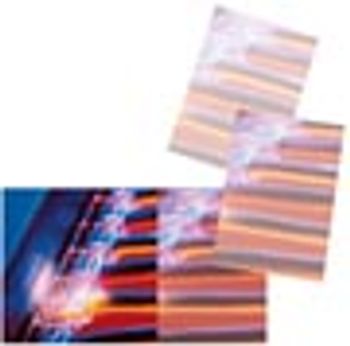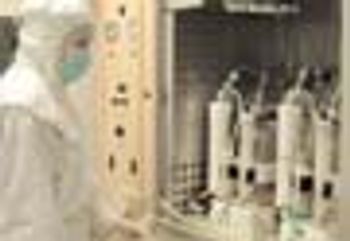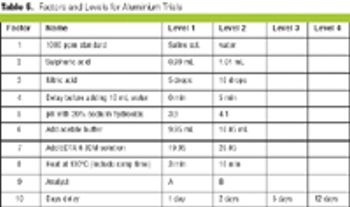
One of the major challenges in fungal biotechnology is preventing proteases of the fungi from degrading recombinant proteins.

One of the major challenges in fungal biotechnology is preventing proteases of the fungi from degrading recombinant proteins.

Alexander Fleming's original process for making penicillin was a low-volume, and presumably, labor-intensive affair. Today, it is a highly optimized, low-budget operation that is carried out only overseas. In other words, says Wei-Shou Hu, PhD, of the University of Minnesota, we engineered ourselves out of a job. Could we do the same with mammalian cell culture? Hu posed this question during a presentation at the BIO conference in April.

The federal government plans to spend $3.3 billion on bird flu initiatives, about half of that on a vaccine.

Anyone who has ever hoisted a glass of a local microbrew has experienced the results of the oldest form of biotechnology?fermentation, the process by which living cells obtain energy through the breakdown of glucose and other molecules. The basic technique of brewing has not changed much in the past 6,000 years, but it is still an excellent illustration of the principles that underlie some of today's most sophisticated biotech production.

To learn more about the processes of fermentation and cell culture used in the production of biopharmaceuticals, you can refer to our advertisers or to the following publications, organizations, and web sites.

Fermentation is an industrial process, but it's probably easier to understand it as something more familiar: raising a living creature. Every fermentation process has to answer several basic questions: Where will the cells live and grow? What will they nourish themselves with? Will the cells live suspended in a mix of water and nutrients (the medium) or do they need to be contained or allowed to attach themselves to a solid base? How will food and air be distributed so all the individual cells get their share? Should all the nutrients the cells need be added at one time, or should the cells be fed additional food as fermentation progresses? How will the progress of fermentation be monitored to ensure the best possible results?

At the heart of modern biotechnology is the ability to manipulate DNA, the astonishing molecule that contains the genetic code of all life on earth. But fermentation and cell culture are also the practical art of keeping cells alive and growing in an artificial environment. As a result, the science of cell culture also includes a healthy focus on the natural processes that keep cells alive.

Many of these terms have more general definitions as well. Those given here are specific to their application in cell culture and fermentation.

As we've shown, biopharmaceutical companies have many options when they choose an expression system: bacteria, yeasts, insect or mammalian cells, and transgenics. Each system has its advantages and disadvantages. Company decision makers must ask themselves several important questions: How much product must be made? How complex is the molecule? Does it require posttranslational modifications to be biologically active? The expression system determines what kind of contaminants will be present and in what quantities. It also determines economic factors: the time scales involved, expression levels obtained, and various regulatory issues. Each potential expression system must be evaluated for its ability to produce economically the maximum amount of biologically active product. Purification methods may be different for products that come from the different host systems. And regulators are more familiar with some systems than with others.

Minimum disruption and maximum gain result when adopting a distributed process control and data management system for a cell culture and fermentation lab.

Over the last three decades, numerous protein expression systems have been developed with various quality requirements on large and small scales. Huge steps have been made in large-scale protein production in mammalian systems while the small-scale mammalian systems are expensive and inflexible. Thus, small-scale production is done in simpler expression systems, sometimes sacrificing the quality of the proteins. However, relief is on the way.

Yeast systems have been a staple for producing large amounts of proteins for industrial and biopharmaceutical use for many years. Yeast can be grown to very high cell mass densities in well-defined medium. Recombinant proteins in yeast can be over-expressed so the product is secreted from the cell and available for recovery in the fermentation solution. Proteins secreted by yeasts are heavily glycosylated at consensus glycosylation sites. Thus, expression of recombinant proteins in yeast systems historically has been confined to proteins where post-translations glycosylation patterns do not affect the function of proteins. Several yeast expression systems are used for recombinant protein expression, including Sacharomyces, Scizosacchromyces pombe, Pichia pastoris and Hansanuela polymorpha.

Managing codon pair interactions and simultaneously optimizing the entire set of parameters requires advanced computationally intensive design tools.

Rapid, efficient, and cost-effective protein expression and purification strategies are required for high throughput structural genomics and the production of therapeutic proteins. Fusion protein technology represents one strategy to achieve these goals. Fusion protein technology can facilitate purification, enhance protein expression and solubility, chaperone proper folding, reduce protein degradation, and in some cases, generate protein with a native N-terminus. No technology or reagent is a panacea, however, and establishing tools and optimal conditions for each protein remains an empirical exercise. With this in mind, protein fusions are a leading option to produce difficult-to-express proteins, especially in Escherichia coli.

The speed at which a recombinant protein product progresses into clinical trials is of vital importance for both small biotechnology companies as well as the biopharma groups of large pharmaceutical companies. For mammalian cell lines, two major impacts on the project timeline are the ability to quickly identify a product candidate and subsequently produce a high-expressing cell line for that product. The advent of various computer-based protein design methodologies and antibody discovery technologies for developing protein therapeutics has resulted in large numbers of protein or antibody variants that must be screened to identify the best clinical candidate.

Development guidelines for MAbs serve as a blueprint for their manufacture, safety, and efficacy testing.

Human infections with avian flu strain H5N1 are occurring in a number of southeast Asian countries that have experienced large outbreaks of avian influenza. How great a risk to the human population is posed by this virus, and what steps can be taken to minimize its impact? Preventive vaccines have great potential to avert the spread of avian flu and other infectious diseases. What are the factors affecting the creation of new vaccines, and how can they be optimized to promote public health?

The cell density achieved in a CELLine bioreactor is typically 1 to 2 orders of magnitude higher than in a conventional culture vessel

Use of a fermentor for cell culture study advances research in directions previously thought unimaginable.

Pharma industry equipment utilization hovers below 40 percent, which would be an unacceptable figure in most industries.

Various methods for transfecting molecules such as DNA, RNA, proteins, or drugs with high efficiency and low toxicity have been implemented and optimized for many different cell types. These include widely used techniques such as chemical transfection (lipid-based techniques), the use of viral vectors and electroporation.

Subcutaneous administration is likely to be an important factor in generating an immunogenic response.

Cell-line and process development expertise, along with disposable systems, assist in implementing strategies for fast expression enhancements.

Strategies for accurate speciation and case studies for the detection of cell line cross-contamination using a commercial kit.

Saturated fractional factorial plans minimize the number of trials by one-half or better, which saves time and money.